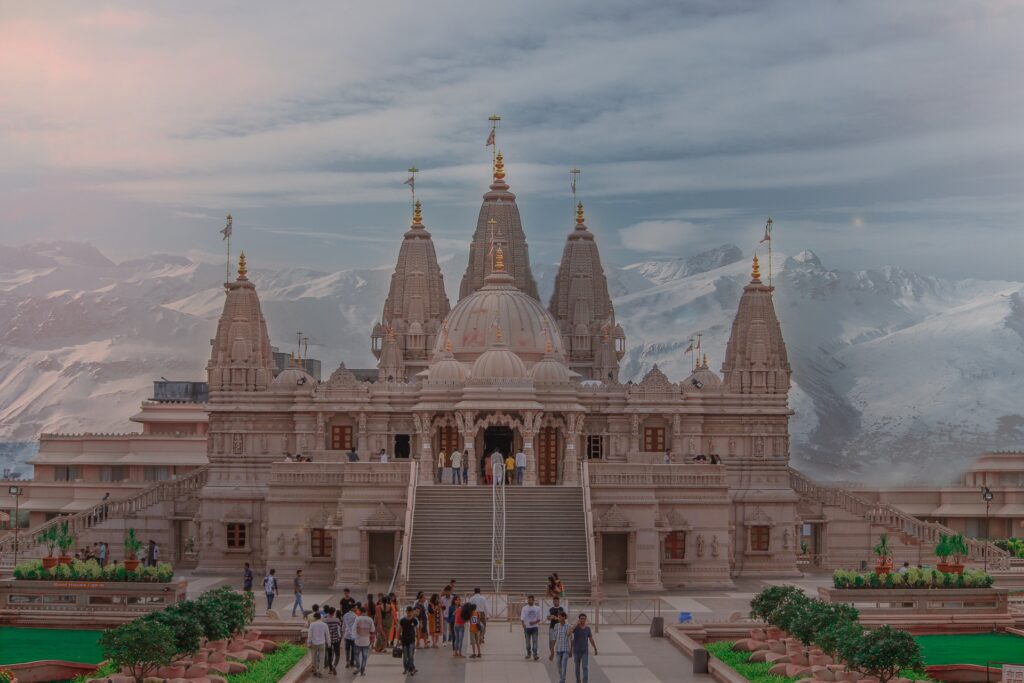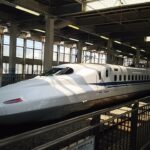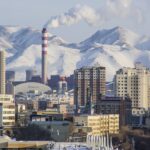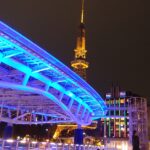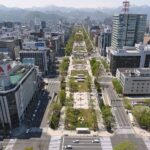Pune’s public transit system offers a fast and dependable option for getting about the city. Pune Mahanagar Parivahan Mahamandal Limited (PMPML) buses, taxis, auto-rickshaws, and a sizable rail system are the city’s primary modes of transportation. The city’s bus system serves most neighborhoods and is always open. Taxis can be hailed on the street or reserved ahead of time. Auto-rickshaws are a convenient mode of transportation, but the fare should be discussed and agreed upon before you get in. Both long-distance and local trains stop in Pune, adding to the city’s convenient accessibility.
Metro system in Pune: basic information
The metro system in Pune is a fairly new transportation system that has quickly gained popularity among locals and visitors alike. The system consists of two lines and one planned line (Line 3), the Pimpri Chinchwad Metro and the Vanaz-Ramwadi Metro, both of which serve the city and the surrounding areas. The system has a total of 10 stations and 23 stations under construction, with the main stations being Shivajinagar, Pimpri Chinchwad, and Pune Station. The system is designed to be fast and efficient, with the trains running regularly throughout the day and night. Additionally, the metro system is integrated with the city bus system, making it easy to travel to and from the metro stations. The metro system in Pune is a great way to explore the city and its surrounding areas.
The lines of the Pune subway system
Purple Line (PCMC Bhavan – Swargate)
The elevated portion of the 16.59-kilometer line, which includes nine stations, will end at Range Hills; the next five stations, located in Swargate, will be located underground.
Aqua Line (Vanaz – Ramwadi)
With 16 stations, the elevated route will have a 14.6 km total length. At the Civil Court interchange station, it will link up with the Purple Line and Line 3. On the site of the former rubbish depot, the Aqua Line maintenance depot will be situated next to the Vanaz station. On March 6, 2022, Prime Minister Narendra Modi dedicated the stretch from Vanaz to Garware College. On August 1, 2023, they opened the part of the line that goes from Garware College to Ruby Hall Clinic
Planned line:
- The Pune Metro Line 3 is the third line of the city’s planned metro system. It will travel through Hinjawadi from the Civil Court in Pune to the Megapolis Pune. The elevated, 23.3-kilometer line will connect with the other lines of the MahaMetro at the Civil Court interchange stop. The work will begin in two stages, with the first focusing on the area between Hinjawadi and Balewadi and the second focusing on the site between Balewadi and the Civil Court in Shivaji Nagar. In Hinjawadi, there will soon be a garage for metro vehicles.
Map of Pune Metro 2023 – Free Download in PDF
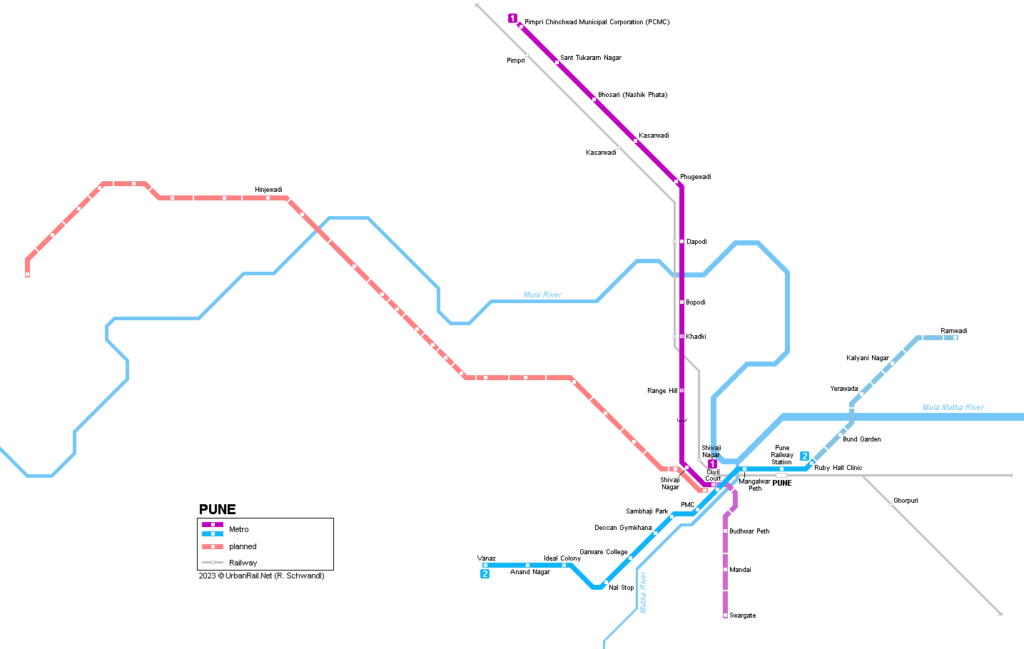
Click on the image and download the map of Pune´s underground system for 2023
The Map of Pune Metro 2023 is a printable PDF that details the city’s public transportation network in great detail. You may find specifics about the city’s lines, stops, interchanges, and more in this guide. Commuters seeking the most direct path to their destination will find this map invaluable. Users can also utilize it to foresee potential transportation issues and prepare for them accordingly. This helpful app, available for no cost, makes using Pune’s public transit system a breeze.
Public transport tickets in Pune – Best types for travelers & actual prices
Pune’s public transportation system accepts a number of different ticket kinds. The all-day ticket is by far the most common choice. For one entire day, you can ride any bus, train, or metro operated by the Pune Municipal Transport Corporation (PMT). The price of a day pass is 40 rupees.
Pune also provides one-way tickets for individuals who are only interested in a brief visit. You can use these tickets once on any PMT vehicle, and they only cost Rs. 10.
Monthly and annual passes are also available if you want to spend a significant amount of time in Pune. Passes are available on a monthly basis for Rs. 300 and on an annual basis for Rs.
The all-day pass is the best value for travelers who will be in Pune for only one day. For just Rs. 40, you can ride any PMT vehicle all day long, giving you unlimited access to the city. If you’re planning on exploring different parts of Pune over the course of three days, the all-day pass is a great way to save money and time.
Timetables & Schedules of Pune Metro system
On weekdays, the Pune Metro runs from 7:00 a.m. to 11:00 p.m., and on weekends and holidays, service begins at 8:00 a.m. and continues until 11:00 p.m. Trains operate every 10 minutes during rush hour and every 15 minutes during off-peak times. There is an 8-minute interval between trains on weekends and holidays. There is a night service on the Pune Metro that operates from 11 p.m. to 5 a.m. on weeknights and 11 p.m. to 6 a.m. on weekends and holidays. On holidays and festivals, the schedule may shift slightly.
What Are Other Options for Public Transportation in Pune?
For many residents of Pune, access to reliable public transit is a basic necessity. The Metro may be the most well-known type of public transit, but there are actually quite a few alternatives. Here’s a look at some options in Pune for those interested in less conventional modes of transportation.
In Pune, India, the PMT (Pune Municipal Transport) buses are the most widely used kind of public transportation. Both air-conditioned and non-air-conditioned bus options are readily available, and service is provided to most neighborhoods. Minibuses serving the city’s outer boroughs are another PMT service.
Auto-rickshaws are another mode of public transportation available to those in Pune. These are common three-wheeled vehicles in urban areas. It is best practice to agree on a fare in advance of taking a ride in order to eliminate any confusion about who is paying for what. Cycle rickshaws, which offer a more relaxed mode of transportation, are widely available around the city. Compared to other modes of transportation, these are more affordable, but they can also be exhausting.
public bus transportation – PMPML
In Pune, buses are the main means of public transit. The Pune Mahanagar Parivahan Mahamandal Limited (PMPML) manages the city’s public transportation system, which consists of more than 500 routes. The typical operating hours for buses are 5:30 am to 11:00 pm, with some night service buses operating until 1:00 am. Bus drivers sell tickets, and an electronic card system called e-Passes is also available.
There are two types of buses in Pune; the regular ones are blue and white, while the air-conditioned ones are blue and yellow. The fare for a ride on a regular bus is around Rs. 9, while the fare for an air-conditioned vehicle is around Rs. A painted number on the side of each bus designates the routes it serves.
The 11, 12, 13, 15, and 33 bus routes are the most frequently traveled in Pune. These lines are the most often used by commuters because of their extensive coverage of the city. The 11, 12, and 13 lines all travel out to the outskirts of the city, while the 15 line travels in the opposite direction, from downtown to the airport. The 33 line operates nightly from 10:00 p.m. to 1:00 a.m. and is a frequently used late-night bus service.
How do the public TRAINS work in Pune?
Both local and intercity train lines radiate out from Pune. The Mumbai-Pune Expressway links the city to Mumbai, the state capital of Maharashtra. Several local trains travel frequently along the freeway, stopping at several different locations. These trains are both practical and inexpensive. Tickets can be purchased at any station, and the cost will depend on how far you ride.
Many long-distance trains make stops at the Pune railway station because it is the principal station in the city. Connectivity within India and to cities in neighboring Karnataka state is excellent. The Deccan Express and the Intercity Express are two of the most well-known trains. It takes about four hours to go between Pune and Mumbai via rail.
Another significant train that links Pune to Bangalore and Mysore is the Pune-Bangalore Express. This train departs daily and arrives at its destination in around twelve hours. This is an excellent method of seeing the many cities and states in southern India.
Connecting Pune to popular destinations like Goa, Mangalore, and Kerala is the Konkan Railway. The journey on this train takes around twenty hours, but it’s well worth it because you get to see so much of the western coast of India.
How To Get From Pune International Airport (PNQ) To The City Center With Public Transport?
Traveling by bus is the most common option for passengers arriving at or departing from Pune International Airport. There is a bus stop right outside the terminal building at the airport. You may take a bus into downtown from here. The trip on the bus won’t take more than 40 minutes at most. From sunrise through night, you won’t have to wait long for a bus because they come regularly.
You can catch a train straight from the terminal if time is of the essence. The Pune International Airport train station is conveniently positioned near the airport’s main terminal. Trains depart approximately once per hour and take about 25 minutes.
From the airport, you can also use shared auto rickshaws, which are a cheaper alternative. Located just outside the station, they provide quick and easy access to the heart of the city in around 40 minutes. Price is roughly 100 ruppes.
how to spend 3 days in Pune?
Start your day in Pune off right by checking out some of the city’s many historical landmarks. The Aga Khan Palace is a museum and monument to the city’s history that dates back to the nineteenth century. Shaniwar Wada, the former palace of the Peshwa emperors, is up next. After seeing the historical sites, relax in the peaceful gardens and meditation halls of the Osho International Meditation Resort.
After taking in the sights and sounds of a city, it’s time to sample the local fare. Aaswad, a vegetarian restaurant serving traditional Maharashtrian food, and Sujata Mastani, a prominent ice cream shake shop, are two of Pune’s most well-known eateries. You can get a taste of the city like no other at the various street vendors. The menus of these mom-and-pop joints feature Indian street foods like pav bhaji, vada pav, and bhel puri, among others.
After the sun goes down, Pune’s exciting nightlife comes to life. Kick off the night at a local watering hole like the High Spirits Cafe, where you can hear some incredible live music. Vapour Bar Exchange is an upscale establishment that serves a wide variety of craft beers and cocktails. Open-air nightclubs with live bands and DJs from around the world are a once-in-a-lifetime opportunity.
Pune is a great place to spend three days because of its history, culture, and modern conveniences. Pune is a city with something for everyone, whether you’re seeking a one-of-a-kind adventure, excellent dining, or a lively nightlife. In that case, why delay any longer? Get ready for a life-changing trip of a lifetime in just three days by visiting Pune.
What other metro systems are nearby to Pune?
Pune, India, is a sizable metropolis with numerous tourist hotspots in close proximity. Those visiting the area won’t have to stress over locating dependable modes of transportation to see the sights. Pune’s proximity to three other cities, each with its own subway system, makes exploration of the region a breeze. Nearby cities with metro systems include Mumbai, Thane, and Nashik. Each suburb is served by its own metro system; Mumbai by the Mumbai Metro, Thane by the Thane-Vashi Metro, and Nashik by the Nashik Metro. Travelers to Pune need not worry about getting to and from other surrounding cities because of the city’s three metro systems.
CHECK OUT THIS AMAZING VIDEO TOUR GUIDE OF PUNE PUBLIC TRANSPORTATION
Summary of our tour guide for Pune
Over the course of my five years in Pune, I have become rather accustomed to the city’s public transit system. Having used public transportation, I can attest to its ease, effectiveness, and availability. Transportation options in the city include buses, autorickshaws, and railroads. The bus ticket is cheap, and there are buses very regularly. The metro system, which I used, is efficient, spotless, and quite pleasant. Although the traffic in Pune can be frustrating at times, the city’s excellent public transportation options make getting about considerably simpler. The public transportation system in Pune is something for which I am quite appreciative.
Top 5 FAQs and answers about Pune public transport?
How much do bus and rail tickets cost in Pune?
- In Pune, bus and train fares vary according on destination. The standard fee for buses costs between 5 and 25 rupees, while train tickets cost between 10 and 60 rupees. Students and the elderly can receive a discount as well.
Secondly, where can I get a ticket?
- Tickets can be purchased at the station’s ticket booth or via automated ticket machines. The mobile app “Pune Smart Card” makes it possible to purchase tickets on the go.
Do you have any deals going on right now?
- Commuters in Pune can take advantage of a number of discounts and deals. Multiple-trip deals, group reservations, and other special offers are all examples.
To what extent do commuters feel safe?
- Pune’s administration has implemented a number of safety measures to protect passengers. CCTV cameras, security guards, and emergency contact numbers are all examples of this.
Where can I find additional resources?
- Pune’s public transportation system has an official website and mobile app where you can find out more information. You may learn everything you need to know about the routes, prices, schedules, and safety precautions from the website and the app. If you have any questions, you can also call your city’s transportation department.
Useful links

